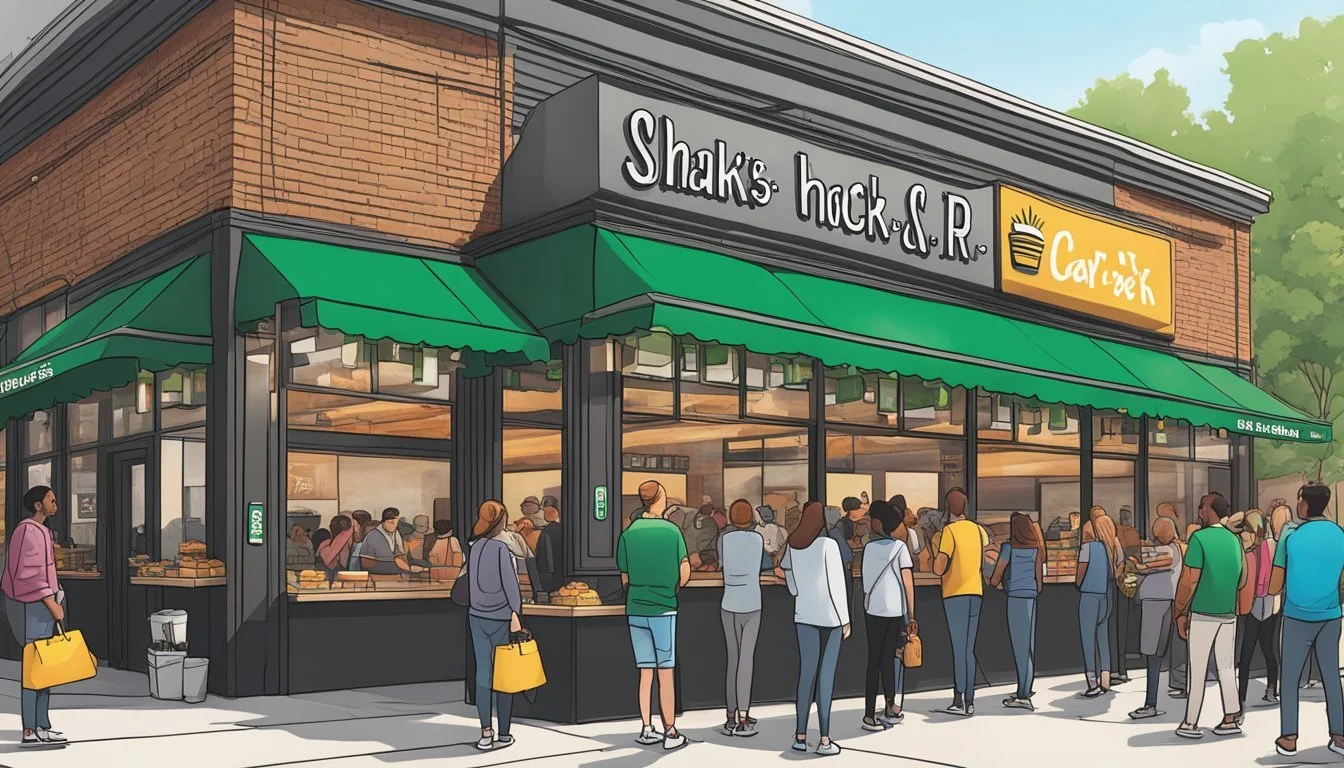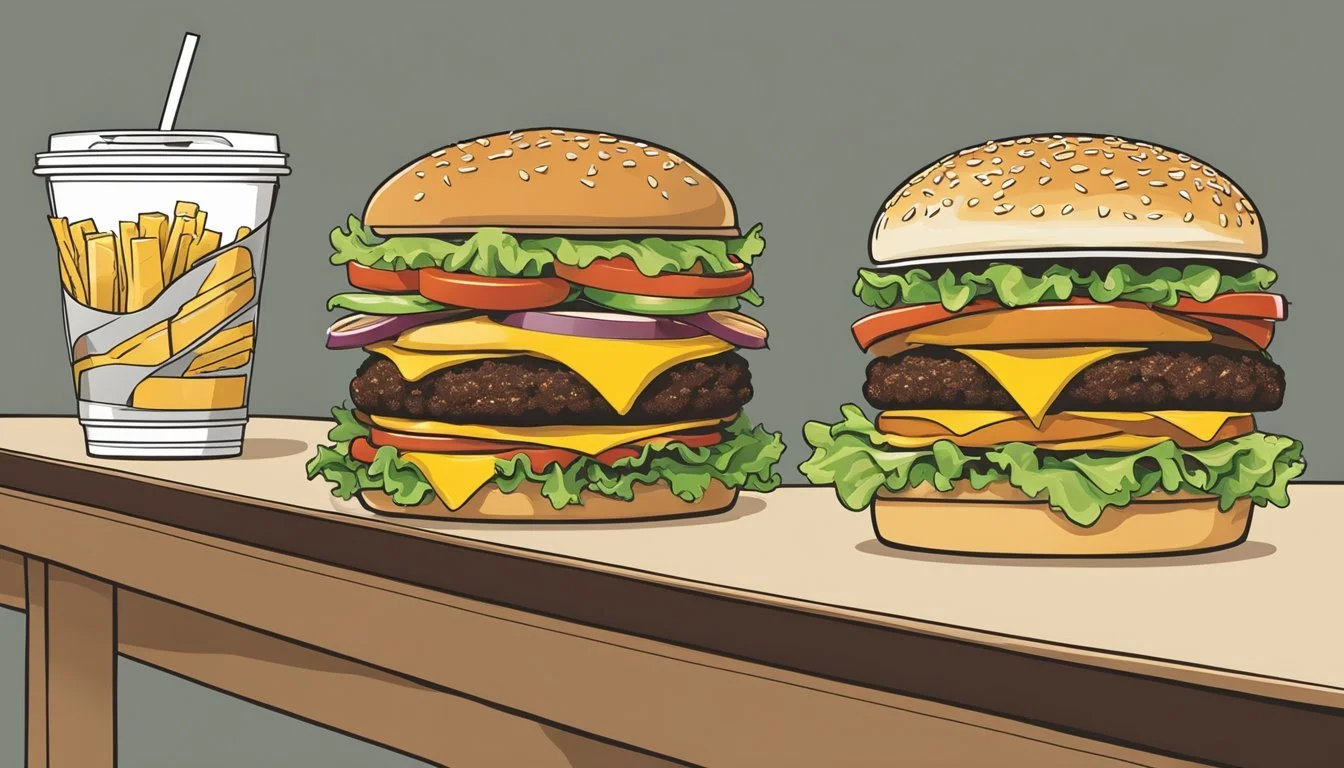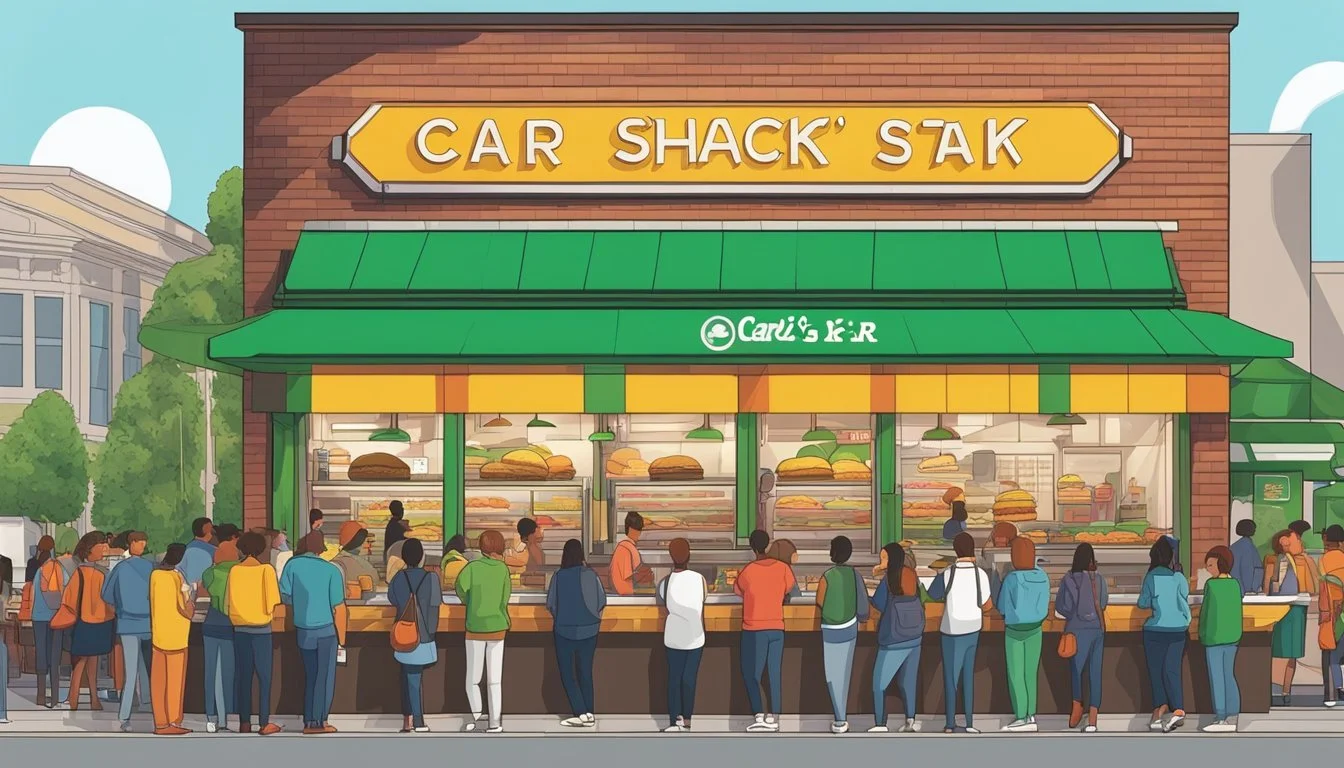Shake Shack vs Carl's Jr.
A Comprehensive Comparison of Burger Havens
In the ever-competitive world of fast food, burger joints stand as titans of taste and convenience. Shake Shack and Carl's Jr. are two powerhouses in this arena, each with its own devoted following and distinct approach to crafting the perfect burger. Shake Shack, with its modern twist on the classic roadside burger stand, emphasizes quality ingredients and has a reputation for its straightforward, non-GMO beef sans hormones or antibiotics. The brand has cultivated an image of offering a premium fast food experience, blending a sit-down restaurant's care with the swift service of a fast food outlet.
Carl's Jr., on the other hand, positions itself as a haven for hearty and adventurous burgers. It's a place where indulgence in a wide variety of toppings and inventive burger creations is not only welcomed but encouraged. The chain's commitment to satisfying a range of cravings places it in a unique spot in the fast food segment. This includes offerings like the Portobello Angus beef burger, signaling a push towards innovation in their menu. The diversity in their burger lineup aims to cater to both traditional palates and those seeking something new.
As consumers' tastes evolve and the demand for higher quality fast food increases, both Shake Shack and Carl's Jr. continue to adapt and vie for the title of the go-to burger destination. While Shake Shack focuses on quality and transparency in its sourcing, Carl's Jr. offers a bold variety that promises a different kind of satisfaction. The question of which is better does not only hinge on the flavor of the burgers themselves but also on the overall dining experience, brand philosophy, and the ability to cater to a wide audience.
History and Origins
Both Shake Shack and Carl's Jr. have distinct origins that have shaped their success in the burger industry. Each brand's history reflects their unique approach to serving customers and creating a burger legacy.
Shake Shack's Beginnings
Shake Shack began as a modest hot dog cart in New York City's Madison Square Park in 2001. It quickly gained popularity and evolved into a permanent kiosk by 2004. The brand's focus on classic American fare, such as burgers and shakes, using high-quality ingredients, has been a key to its success and expansion.
Carl's Jr. Historical Background
Carl's Jr. was established in 1941 by Carl Karcher, who started with a hot dog cart in Los Angeles before opening a full-service restaurant named Carl's Drive-In Barbecue in 1945. The introduction of the fast-food concept led to the first "Carl's Jr." in 1956, emphasizing quick service and portable meals. Over the decades, Carl's Jr. has grown significantly and is known for its innovative menu items and memorable marketing campaigns.
Menu Offerings
In evaluating Shake Shack and Carl's Jr., one must consider the diversity of their burger varieties and the range of other menu items each offers.
Burger Varieties
Shake Shack prides itself on a concise menu of gourmet-style burgers, with their signature offering being the ShackBurger. Guests can opt for single or double patties, typically made from Angus beef, which are seared to perfection. The chain stands out for its potato rolls, and proprietary ShackSauce, which lend a unique flavor profile to their burgers. Cheese, lettuce, tomato, and pickle are staple toppings, with the option to add applewood-smoked bacon.
Carl's Jr. differentiates itself with a broader selection for more customized experiences. Their Original Six Dollar Burger can be dressed with a variety of cheeses, toppings, and sauces, catering to guests who desire a more tailored burger. Carl's Jr. also offers a range of thick angus beef patties that are char-broiled, giving their burgers a distinctive char-grilled taste.
Other Menu Items
Both burger chains complement their offerings with an array of fast food favorites. Shake Shack provides a simpler menu with a focus on quality ingredients, including milkshakes made with real dairy ice cream and fresh fries cut from whole potatoes. The chain maintains a narrow focus, ensuring a consistent and premium experience pertaining to beef and shakes.
Carl's Jr. boasts a comprehensive menu beyond burgers, including a variety of chicken sandwiches, salads, and breakfast items. This allows them to appeal to a wider audience at any time of the day. In addition to hamburgers, they serve hand-breaded chicken tenders and a selection of milkshakes alongside other classic fast food offerings.
Burger Quality
When comparing Shake Shack and Carl's Jr., it is essential to focus on the core aspects of their offerings: the meat quality and the ingredients used, as well as the freshness and distinct flavor profiles that each brand brings to their burgers.
Meat and Ingredients
Shake Shack sources 100% all-natural Angus beef, which is free from hormones and antibiotics. This commitment to quality meat may contribute to the burgers' reputation for being flavorful and juicy. The ingredients used in Shake Shack burgers are selected with an eye for freshness, and in many cases, they are non-GMO and organic.
On the other hand, Carl's Jr. offers a variety of burgers including their 100% Black Angus beef Thickburger® line. While there has been no definitive statement about the use of hormones and antibiotics, Carl's Jr. has made strides in offering healthier options like the All-Natural Burger, which features beef free from added hormones, antibiotics, and steroids.
Freshness and Flavor Profiles
Shake Shack's burgers are known for their freshness and custom blend of meat, which is cooked to a distinctive sear and seasoned to enhance the taste. Shake Shack's toppings, like their green leaf lettuce and vine-ripened tomatoes, complement the seasoned, juicy beef perfectly.
Carl's Jr. also takes pride in the freshness and flavors of their burgers. They coined the term "charbroiled" to describe their burger-cooking process, which implies a smokier, grilled taste that informs their burgers' flavor profiles. Seasonings and sauces are applied to pair with the charbroiled meat, aiming to create a memorable taste experience.
Brand Personality
Shake Shack and Carl's Jr. present unique brand personalities that reflect their individual takes on the fast-food burger industry, with Shake Shack leaning into a gourmet experience and Carl's Jr. embracing a traditional fast-food approach.
Marketing and Brand Image
Shake Shack:
Emphasizes a modern and premium image.
Markets itself as a provider of gourmet burgers, highlighting quality ingredients and chef-driven recipes.
Carl's Jr.:
Focuses on a more classic fast-food image with bold flavors.
Markets its offerings through attention-grabbing campaigns and a longstanding tradition in the fast-food sector.
Dining Experience and Ambiance
Shake Shack:
Offers a contemporary, relaxed dining experience with an emphasis on community space.
Features a stylish ambiance that caters to a clientele seeking more than just a quick bite, often located in trendy, urban locations.
Carl's Jr.:
Provides a straightforward, fast-food dining experience known for convenience and speed.
The ambiance is typically less focused on the aesthetic of the space and more on efficiency, catering to customers looking for traditional fast-food comfort.
Price Point and Value
When comparing Shake Shack and Carl's Jr., price and value are considerable factors for consumers. Shake Shack is known for its premium positioning within the fast-food spectrum, where customers might expect to pay around $16 for a combination of cheese fries and a double Shake Burger. This price point reflects the brand's focus on quality ingredients and a modern, upmarket experience.
Contrastingly, Carl's Jr. markets itself as offering affordable, hearty meals with a more traditional fast-food approach. They cater to consumers looking for satisfying portions and familiar flavors at a reasonable price. While not as low-cost as some competitor chains, Carl's Jr. generally maintains a balance between cost and portion size, making it a middle-tier option in terms of price.
Shake Shack
Basic Burger: Starts around $5.29
Signature Burger: Can reach upwards of $9
Combo Meal: Around $12-$16
Carl's Jr.
Basic Burger: Starts around $3.29
Signature Burger: Typically under $7
Combo Meal: Approximately $6-$9
Shake Shack takes pride in their fine-dining roots, with a focus on culinary expertise and ingredient sourcing. They serve a proprietary blend of meats and boast a variety of unique shakes and custards. At Carl's Jr., customers can expect more conventional menu items with a wide range of sauces and toppings offered at no additional cost.
Consumers often weigh the value of their purchase in terms of not just price but also quality, portion size, and the overall dining experience. Each restaurant targets a different segment of the fast-food market, with Shake Shack leaning towards a premium experience and Carl's Jr. sticking closer to the traditional, value-oriented fast-food model.
Consumer Perceptions and Reviews
Consumer choices between Shake Shack and Carl's Jr. are often swayed by individual experiences and professional critiques. These perceptions are vital to understanding the strengths and weaknesses of each brand.
Customer Loyalty
Shake Shack enjoys a zealous fan base, particularly in urban centers where its reputation for quality ingredients and an innovative menu resonates with a food-conscious clientele.
Carl's Jr., traditionally seen as a staple in the fast-food burger market, garners loyalty through its consistent quality and signature offerings like the Portobello Angus beef burger.
Critics and Expert Opinions
Critics often highlight Shake Shack's premium positioning in the market, hailing its succulent beef patties and fresh, modern take on fast-casual dining. Conversely, experts appreciate Carl's Jr. for providing a more traditional burger experience with a focus on hearty and indulgent recipes. Their Portobello Angus beef burger, for example, has been noted for its unique flavor profile amongst mainstream burger offerings.
Nutritional Information
When comparing Shake Shack and Carl's Jr., customers often scrutinize the nutritional content of their burger choices. Information such as calorie count, fat content, and presence of organic ingredients come into focus, especially for health-conscious diners.
Health Conscious Options
Shake Shack caters to a variety of dietary preferences, including vegan options like the Veggie Shack. This particular item, when ordered in its vegan and lettuce-wrapped form, provides a reasonable nutritional profile:
Calories: 310
Total Fat: 18g
Saturated Fat: 1.5g
Carbohydrates: 31g
Protein: 4g
Sodium: 900mg
Furthermore, Shake Shack's beef is 100% all-natural Angus, boasting no hormones and no antibiotics, which appeals to those concerned about steroids in their meat.
On the other hand, Carl's Jr. offers selections like the Big Carl, which has a substantial nutritional footprint:
Calories: 930
Total Fat: 58g
Saturated Fat: 23g
Protein: 42g
Carl's Jr. does not expressly highlight the use of organic ingredients or a specific stance on steroids and antibiotics in their standard menu offerings.
Caloric Comparisons
A side-by-side comparison of similar burgers at both joints sheds light on the caloric differences. For single patty options:
Single ShackBurger® at Shake Shack: 500 Calories
The Big Carl® at Carl's Jr. (estimated single patty equivalent): 465-500 Calories (approximation based on the double patty version)
When advancing to double patty burgers:
Double ShackBurger® at Shake Shack: 760 Calories
The Big Carl® at Carl's Jr.: 930 Calories
While both restaurants offer a range of options, Shake Shack's menu items tend to present a more detailed breakdown of their nutritional content, particularly with a nod to the absence of hormones and antibiotics.
Cultural Impact
Shake Shack and Carl's Jr. have distinct places in the cultural landscape of American fast food chains. Shake Shack began life as a hot dog cart in Madison Square Park, New York City, and has grown into an international phenomenon. It represents a new era of fast-casual dining, combining premium ingredients with an ethos of modernity and urban culture. The chain is often associated with upmarket urban environments and has a loyal following that appreciates its commitments to sustainability and community engagement.
On the other hand, Carl's Jr., which opened its doors in 1941, has long been a staple of American fast food, especially in the West. Known for its bold and often controversial marketing strategies, Carl's Jr. has cemented its status in American pop culture. The chain has garnered attention for its creative advertisements featuring celebrities and for not shying away from indulgent menu items.
When it comes to American cheese, a standard feature in the fast food burger world, both chains include it as a staple ingredient in their offerings. Shake Shack often emphasizes the quality of its natural Angus beef and shuns hormones and antibiotics, adding a slice of American cheese to its signature ShackBurger. Meanwhile, Carl's Jr. presents a variety of burgers that include American cheese, appealing to traditional tastes and preferences.
Brand Comparison
Shake Shack
Image: Urban, modern image
Origins: Contemporary, New York City roots
Ingredients: Premium ingredients
Marketing: Bold marketing
Presence: International presence
Pop Culture: Integration in pop culture
Sustainability: Sustainability-focused
Menu: Varied menu with indulgent options
Carl's Jr.
Image: Traditional, West Coast origins
Origins: Classic fast-food roots
Ingredients: Varied quality
Marketing: Bold advertising campaigns
Presence: Strong presence primarily in the U.S.
Pop Culture: Notable for edgy marketing
Sustainability: Limited sustainability initiatives
Menu: Varied menu with indulgent options
These distinctive brands both shape and are shaped by the cultural tastes of their customers. Whether it's the upscale, environmentally conscious appeal of Shake Shack or the tried-and-true, hearty Americana of Carl's Jr., each has carved out a place in the competitive landscape of American fast food.
Conclusion
When comparing Shake Shack and Carl's Jr., consumers will find distinct differences that cater to a variety of preferences.
Shake Shack is renowned for its commitment to quality with antibiotic-free beef and a modern take on the classic American burger joint. Its menu, while somewhat limited compared to Carl's Jr., emphasizes fresh ingredients and has garnered a following for its ShakeBurgers.
Carl's Jr., on the other hand, offers a broader menu with a range of options beyond burgers, such as chicken and salads. It's often recognized for its inventive burger creations and reasonable pricing, appealing to those seeking variety and value.
In terms of ambiance, Shake Shack typically provides a more upscale, fast-casual experience, while Carl's Jr. stays true to its fast-food roots with a more casual dining environment.
For those prioritizing environmentally friendly and health-conscious dining options:
Shake Shack's approach is likely more appealing with its higher grades for serving antibiotic-free beef.
For customers who value variety and affordability:
Carl's Jr. may be the preferred choice due to its extensive menu and competitive pricing.
The decision between Shake Shack and Carl's Jr. ultimately rests on the individual's taste preference, dietary considerations, and the dining experience they seek. Both establishments offer compelling reasons to visit, whether it's for a quality-focused burger or a diverse menu that caters to a wide range of tastes.









